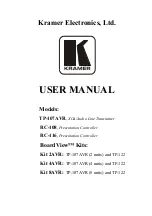
36
Coded Orthogonal Frequency Division Multiplex (COFDM)
Modulation
COFDM is used for microwave applications like wireless cameras and mobile video links because of its
tolerance to multipath transmission errors. In addition COFDM offers more than twice the spectral efficiency
of comparable FM analog microwave transmission.
COFDM does not rely on the vulnerability of a single carrier but spreads the digital information over many
narrow band carriers using Frequency Division Multiplex (FDM). The bandwidth and the data rate on each of
these carriers are reduced and therefore the RF robustness is increased. The carriers are accurately spaced and
orthogonal, which means they can be generated and recovered without carrier specific filtering. Even though
the spectra of adjacent carriers significantly overlap, each carrier can be demodulated without crosstalk from
its neighbors.
The main COFDM parameters are:
•
Number Of Sub-Carriers (About 2,000 In Our Case)
•
The Symbol
•
Individual Sub-Carrier Modulation
•
Guard Interval (GI) Duration Between COFDM Symbols
•
Data Redundancy Code Rate Used For Error Correction
Symbols
The active symbol is the period that digital information is sampled. The number of bits carried in each
symbol depends on the choice of modulation.
Modulation
Modulation is the process of varying a carrier signal in order to use that signal to convey information.
Quadrature amplitude modulation (QAM) is a modulation scheme which conveys data by changing
(modulating) the amplitude and phase of two carrier waves. BMS uses the forms QPSK, 16QAM, and
64QAM.
QPSK
2 bits/symbol
16 QAM
4 bits/symbol
64 QAM
6 bits/symbol
The higher-order QAM has a higher susceptibly to noise and other corruption. 64QAM will transmit more
bits per symbol but with higher bit error rate. It is a less robust signal, but over an easy transmission path
(studio setting) it probably won’t matter. More difficult transmission paths (mobile or aerial over long ranges
with lots of interference from trees and buildings) will require a more robust signal.
Guard Interval (GI)
The guard interval acts as a buffer to protect the active symbol from echoes. A guard interval is added to the
beginning of each symbol to allow time for echoes to settle before beginning the active symbol period. A
wide range of guard interval options are available from
to
. This fraction represents the ratio between the
guard interval to the active symbol period.
Содержание Truck-Coder II
Страница 2: ...This Page Intentionally Left Blank ...
Страница 4: ...ii This Page Intentionally Left Blank ...
Страница 16: ...8 This Page Intentionally Left Blank ...
Страница 18: ...10 This Page Intentionally Left Blank ...
Страница 20: ...12 This Page Intentionally Left Blank ...
Страница 22: ...14 Figure 5 ODU Footprint ...
Страница 24: ...16 This Page Intentionally Left Blank ...
Страница 32: ...24 ...
Страница 34: ...26 This Page Intentionally Left Blank ...
Страница 37: ...29 ...
Страница 43: ...35 This Page Intentionally Left Blank ...
Страница 47: ...This Page Intentionally Left Blank ...






































